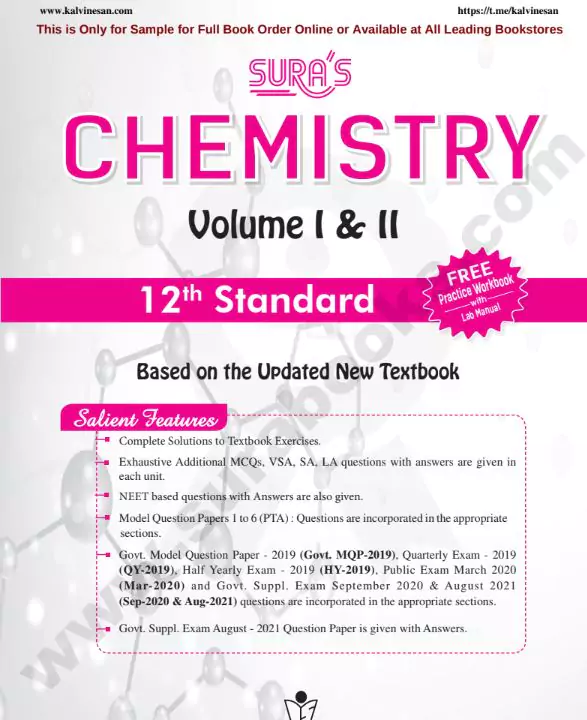’12th Chemistry Guide’ PDF Quick download link is given at the bottom of this article. You can see the PDF demo, size of the PDF, page numbers, and direct download Free PDF of ’12th Chemistry Guide’ using the download button.
12th Chemistry Guide PDF Free Download

12th Chemistry Guide
12th Chemistry Guide PDF – Chapter 1: Solid State
This chapter explains the solid state, crystal lattice, classification of solids, general characteristics of solids, and imperfections in the unit cell. Matter exists in three states – solid, liquid, and gas.
Solids are further divided into – crystalline and amorphous. Crystalline has a definite shape, while amorphous has no shape.
NCERT Solutions are a perfect guide to getting a strong hold on these concepts. To further consolidate the concepts, students can also use NCERT Exemplar Solutions which are available on BYJU’S.
Chapter 2: Solutions
A solution is a mixture of two or more components. This chapter helps the students to understand the concentration of solutions, types of solutions, the vapor pressure of liquid solutions, the solubility of gases and solids in liquid, ideal and non-ideal solutions, and Raoult’s law.
There are also various problems based on finding molarity, mole fraction, mass percentage, and Henry’s law constant. These problems are not only important for class 12 exams but also more important in competitive exams like JEE Mains, JEE Advanced, etc.
Chapter 3: Electrochemistry
Electrochemistry is defined as the branch of chemistry that deals with the relationship between electrical and chemical energy generated in redox reactions and their conversion.
The concepts covered in this chapter are – electrochemical cell, galvanic cell, Nernst equation, conduction of electrolytic solutions, electrolytic cell and electrolysis, battery, fuel cell, and corrosion. Students who are not able to solve numerical problems can also refer to NCERT solutions and can easily answer them.
Chapter 4: Chemical Kinetics
This chapter will give you a good understanding of the rate of chemical reaction, the Arrhenius equation, the rate dependence of reaction, and the collision theory of chemical reaction.
Chemical kinetics is a branch of chemistry that deals with the rate of a chemical reaction, the factors affecting it, and the mechanism of the reaction. According to the rate of reaction, we have 3 types – immediate reactions, slow reactions, and medium-slow reactions.
Chapter 5: Surface Chemistry
Surface chemistry deals with important features such as catalysis, adsorption, and colloids which include gels and emulsions.
After reading this chapter, the student will be able to understand the interfacial phenomena and their importance, adsorption and its classification, the mechanism of adsorption, and factors controlling adsorption.
Solving textbook questions along with the previous year’s question papers will boost the exam preparation of CBSE students.
Chapter 6: General Principles and Processes of Separation of Elements
Metallurgy is a scientific and technological process followed to separate metals from their ores. In addition to explaining the processes and reactions of metal extraction, students will also learn about the fundamental principles and developments in this field.
Aluminum is the most abundant metal found on the earth’s crust accounting for 8.3% by weight. Hence cleaning the ore, i.e. removal of particles like clay, sand, etc., is known as concentration or dressing of the ore.
| Language | English |
| No. of Pages | 57 |
| PDF Size | 2 MB |
| Category | Education |
| Source/Credits | drive.google.com |
Related PDFs
Regulation Of Insurance Business PDF
BEGAE 182 Important Questions with Answers PDF
Practice Of General Insurance 4th Sem PDF
Vayana Dinam Quiz 2023 PDF In Malayalam
12th Chemistry Guide PDF Free Download
